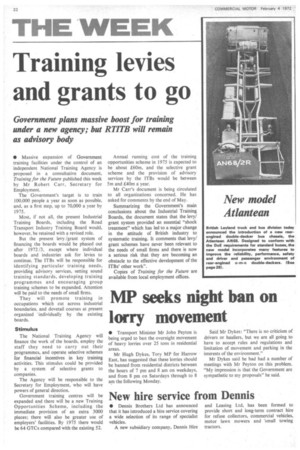Training levies and grants to go
Page 24

If you've noticed an error in this article please click here to report it so we can fix it.
Government plans massive boost for training under a new agency; but RTITB will remain as advisory body
• Massive expansion of Government training facilities under the control of an independent National Training Agency is proposed in a consultative document. Training for the Future published this week by Mr Robert Carr, Secretary for Employment.
The Government's target is to train 100,000 people a year as soon as possible, and, as a first step, up to 70,000 a year by 1975.
Most, if not all, the present Industrial Training Boards, including the Road Transport Industry Training Board would, however, be retained with a revised role.
But the present levy /grant system of financing the boards would be phased out after 1972 /3, except where individual boards and industries ask for levies to continue. The ITBs will be responsible for identifying particular training needs, providing advisory services, setting sound training standards, developing training programmes and encouraging group training schemes to be expanded. Attention will be paid to the needs of small firms.
They will promote training in occupations which cut across industrial boundaries, and dovetail courses at present organized • individually by the existing boards.
Stimulus The National Training Agency will finance the work of the boards, employ the staff they need to carry out their programmes, and operate selective schemes for financial incentives in key training activities. This stimulus could be provided by a system of selective grants to companies.
The Agency will be responsible to the Secretary for Employment, who will have powers of general direction.
Government training centres will be expanded and there will be a new Training Opportunities Scheme, including the immediate provision of an extra 3000 places; there will also be greater use of employers' facilities. By 1975 there would be 64 GTCs compared with the existing 52. Annual running cost of the training opportunities scheme in 1975 is expected to be about £60m, and the selective grant scheme and the provision of advisory services by the ITBs would be between 5m and £40m a year.
Mr Carr's document is being circulated to all organizations concerned. He has asked for comments by the end of May.
Summarizing the Government's main conclusions about the Industrial Training Boards, the document states that the levy/ grant system provided an essential "shock treatment" which has led to a major change in the attitude of British industry to systematic training. It comments that levy/ grant schemes have never been relevant to the needs of small firms and there is now a serious risk that they are becoming an obstacle to the effective development of the ITBs' other work".
Copies of Training for the Future are available from local employment offices.














































































































































